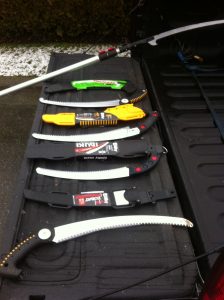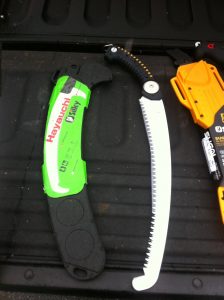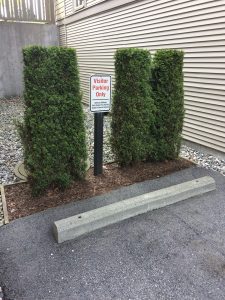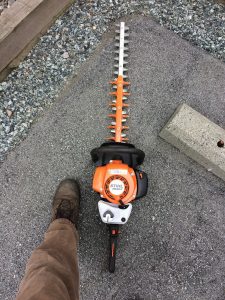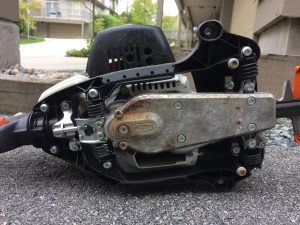Spring. It’s a time of renewal and, as the Tri-City News reminded me recently, it also brings out salesmen. But don’t worry, you don’t have to let them in. And you have thirty days to change your mind if your purchase is over $50. Good to know.
I was thinking about this after I had a salesman visit me in the field. The guy simply drove by my work site and saw my piles of branches. My goal for the day was to thin out Robinia pseudoacacias. So he stopped and searched out the sweaty arborist. Normally, I brush salesmen off but in this case, I was very happy to talk to him. As it turned out, he had lots of ‘toys’ in his truck.
Arborist ‘toys’
Doug pulled out a telescoping pole saw which was awesome. It’s a bit heavy but the telescoping is nice. The hand saws had me drooling. I especially liked the hand saws that attach to your leg for easy access. One day, when budget allows, I will invest in one.
Right now I am happy with my Samurai hand saw I purchased in Japan for about $35. Always get good quality steel. Having a nice, sharp saw is critical. I still remember a seminar I took at the UBC botanical garden years ago. They had an arborist doing a demonstration in a tree and his hand saw was gorgeous. Light reflected off the saw and it made a beautiful sound when it cut through the wood. I wanted one like that ever since.
Later on, the same arborist pointed out that his hard hat is worn to separate himself from landscapers. Aha! I was insulted and too shy to interrupt the demonstration. Hard hats are for safety. There are many professionals like me who are both ISA certified arborists and landscapers. Skilled, total professionals. My focus is on good quality work, not on separating myself from anybody. Remember, be so good so they can’t ignore you!
Sales details
I am very happy to plug a green salesman in a blog post. Always help others succeed. Unfortunately, many companies have go-to dealers so it’s up to the salesman to spin his magic and develop new relationships. Saws get dull and abused. You will need new ones.
Doug Cox of Calmac Saw & Supply can be reached at 604-816-6915 or calmacsaw@gmail.com. Please tell him you found him through this blog. Perhaps he can demonstrate his saws for you.


